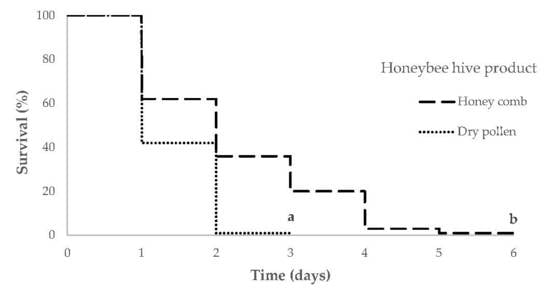Survival of Ectoparasitic Mites Tropilaelaps mercedesae in Association with Honeybee Hive Products
Abstract
:1. Introduction
2. Materials and Methods
3. Results
4. Discussion
5. Conclusions
Author Contributions
Funding
Acknowledgments
Conflicts of Interest
References
- Mutinelli, F. The spread of pathogens through trade in honeybees and their products (including queen bees and semen): Overview and recent developments. Rev. Sci. Tech. OIE 2011, 30, 257–271. [Google Scholar] [CrossRef]
- Sammataro, D.; Gerson, U.; Needham, G. Parasitic mites of honeybees: Life history, implications, and impact. Annu. Rev. Entomol. 2000, 45, 519–548. [Google Scholar] [CrossRef] [PubMed]
- Terrestrial Animal Health Code. Section 9. Apidae. Chapter 9.5. Infestation of Honeybees with Tropilaelaps spp. 2019. Available online: http://www.oie.int/en/standard-setting/terrestrial-code/access-online/ (accessed on 9 January 2019).
- Neumann, P.; Pettis, J.S.; Schäfer, M.O. Quo vadis Aethina tumida? Biology and control of small hive beetles. Apidologie 2016. [Google Scholar] [CrossRef]
- Delfinado-Baker, M.; Rath, W.; Boecking, O. Phoretic bee mites and honeybee grooming behavior. Int. J. Acarol. 1992, 18, 315–322. [Google Scholar] [CrossRef]
- Rinderer, T.E.; Oldroyd, B.P.; Lekprayoon, C.; Wongsiri, S.; Boonthai, C.; Thapa, R. Extended survival of the parasitic honeybee mite Tropilaelaps clareae on adult workers of Apis mellifera and Apis dorsata. J. Apic. Res. 1994, 33, 171–174. [Google Scholar] [CrossRef]
- Koeniger, N.; Muzaffar, N. Lifespan of the parasitic honeybee mite, Tropilaelaps clareae, on Apis cerana, dorsata and mellifera. J. Apic. Res. 1988, 27, 207–212. [Google Scholar] [CrossRef]
- Woyke, J. Tropilaelaps clareae females can survive for four weeks when given open bee brood of Apis mellifera. J. Apic. Res. 1994, 33, 21–25. [Google Scholar] [CrossRef]
- Khongphinitbunjong, K.; de Guzman, L.I.; Burgett, M.D.; Rinderer, T.E.; Chantawannakul, P. Behavioral responses underpinning resistance and susceptibility of honeybees to Tropilaelaps mercedesae. Apidologie 2012, 43, 590–599. [Google Scholar] [CrossRef]
- Anderson, D.L.; Roberts, J.M.K. Standard methods for Tropilaelaps mites research. J. Apic. Res. 2013, 52, 1–16. [Google Scholar] [CrossRef]
- Woyke, J. Comparative population dynamics of Tropilaelaps clareae and Varroa jacobsoni mites on honeybees. J. Apic. Res. 1987, 26, 196–202. [Google Scholar] [CrossRef]

© 2019 by the authors. Licensee MDPI, Basel, Switzerland. This article is an open access article distributed under the terms and conditions of the Creative Commons Attribution (CC BY) license (http://creativecommons.org/licenses/by/4.0/).
Share and Cite
Khongphinitbunjong, K.; Chantawannakul, P.; Yañez, O.; Neumann, P. Survival of Ectoparasitic Mites Tropilaelaps mercedesae in Association with Honeybee Hive Products. Insects 2019, 10, 36. https://doi.org/10.3390/insects10020036
Khongphinitbunjong K, Chantawannakul P, Yañez O, Neumann P. Survival of Ectoparasitic Mites Tropilaelaps mercedesae in Association with Honeybee Hive Products. Insects. 2019; 10(2):36. https://doi.org/10.3390/insects10020036
Chicago/Turabian StyleKhongphinitbunjong, Kitiphong, Panuwan Chantawannakul, Orlando Yañez, and Peter Neumann. 2019. "Survival of Ectoparasitic Mites Tropilaelaps mercedesae in Association with Honeybee Hive Products" Insects 10, no. 2: 36. https://doi.org/10.3390/insects10020036






